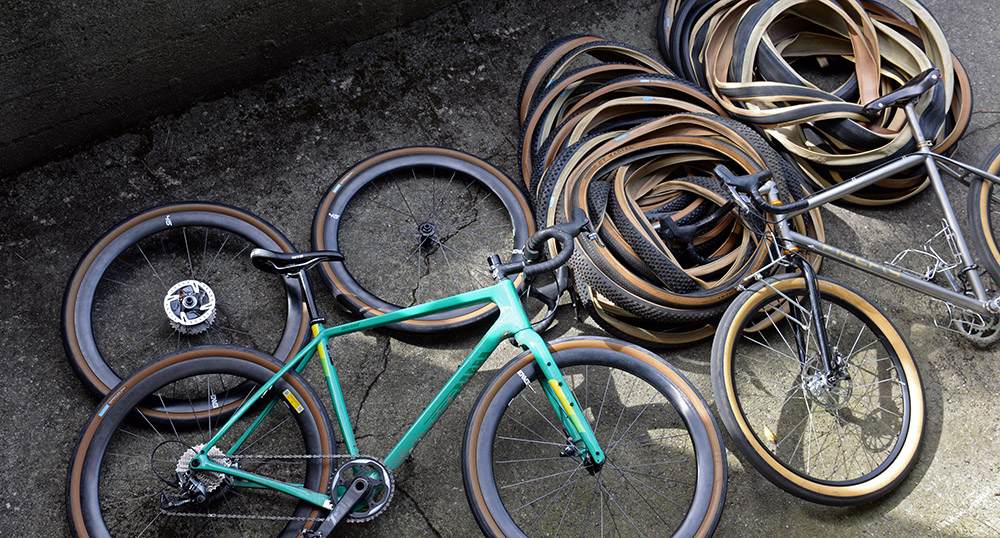Tire Test Results
Last week, we talked about how real-road tire tests have revolutionized our understanding of how bicycles work. We’ve looked at different ways of testing tires, and why it’s so important to perform tests carefully and under realistic conditions. Today, let’s look at some results of our testing.
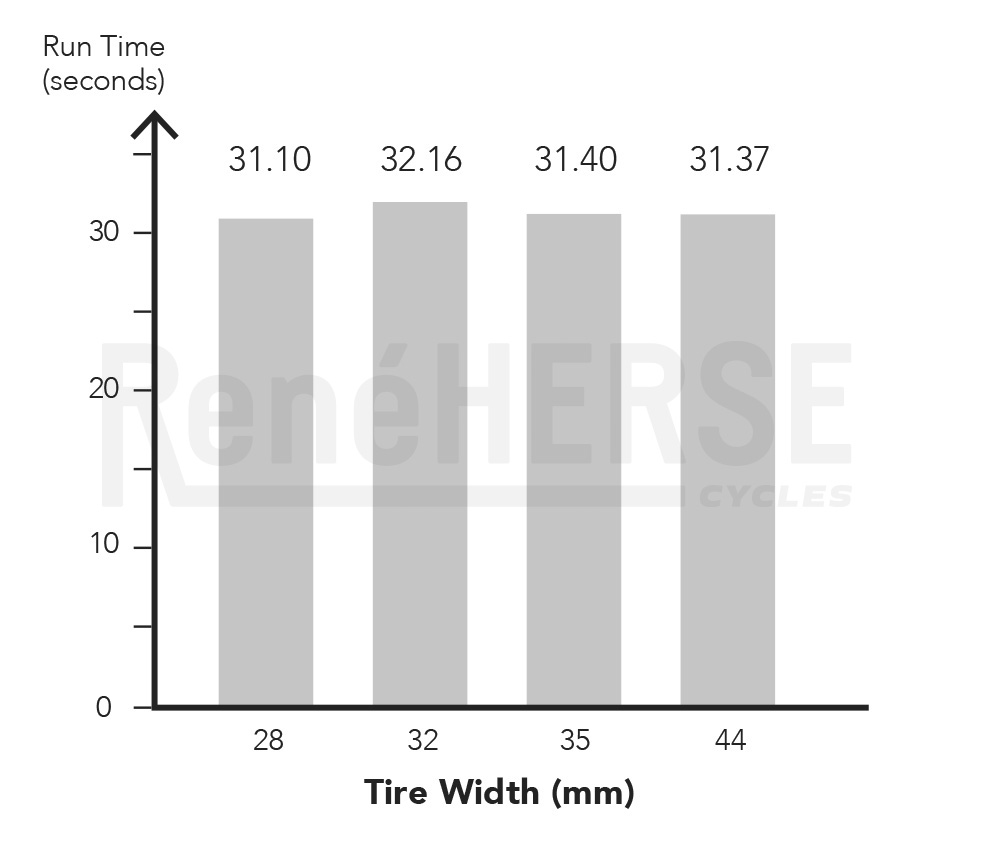
Are Wider Tires Slower? Or Faster?
The answer is simple: ‘Neither.’ Above is one of many tests where we compared tires with the same casings (Rene Herse Extralights) in different widths – the numbers show the time it took to roll through the timed section of our 132 m-long test hill. (We did multiple runs for each tire to get more precision; above are the averages.) The tiny differences between 28, 32, 35 and 44 mm-wide tires are not statistically significant – they are the inevitable ‘noise’ that you get with all tests. We tested at low speeds (15 km/h; 9 mph) to isolate rolling resistance and minimize the effect of aerodynamics on our results.
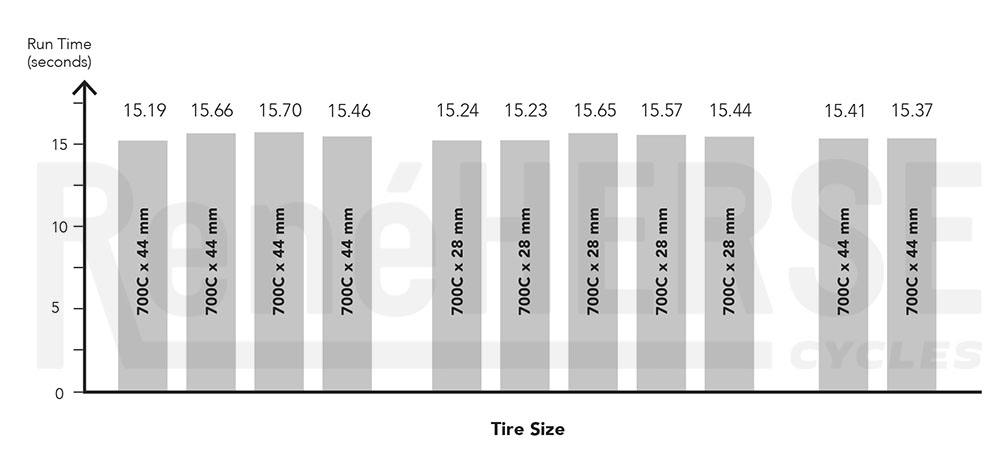
What about the wind resistance of wider tires? Above is data from higher speeds (29 km/h; 18 mph) that confirm: Even at speeds where aerodynamics become an important factor, 44 mm-wide tires are no slower than 28s. (Above shows a typical test run: We ran the wide tires four times, then the narrow tires five times, then the wide tires twice, to make sure that conditions hadn’t changed.)
Why aren’t wider tires less aero? Even a 44 mm-wide tires doesn’t have a large frontal area, and on modern bikes, the down tube is wider than that. When did somebody suggest that a wider down tube slows your bike down significantly? This isn’t to say that with certain wheel configurations and perhaps in crosswinds, wide tires couldn’t be very slightly less (or more) aero than narrow tires, but at least for the tire widths we run on all-road bikes, there’s no real benefit from going to narrower tires to gain speed. Other factors are much more important (see below).
These tests were performed on smooth pavement – the most favorable surface for narrow tires. If narrow tires aren’t faster on smooth pavement, they won’t be faster anywhere (except perhaps on a wooden track surface).
This still goes against what many cyclists believe – or even feel, because there is a tendency to equate vibration with speed, and narrow tires vibrate at higher frequencies. (We call this the ‘placebo effect’ of narrow tires.) And yet we can consider this settled – it’s been shown so many times, in so many tests, with different methods. (But your riding buddies may still tell you that you’d be faster on narrower tires.)
What about rough roads? That’s where the suspension losses become even more important, and wider tires are definitely faster. In conclusion: On smooth roads, wide tires are as fast as narrow ones. On rough roads, they are faster.
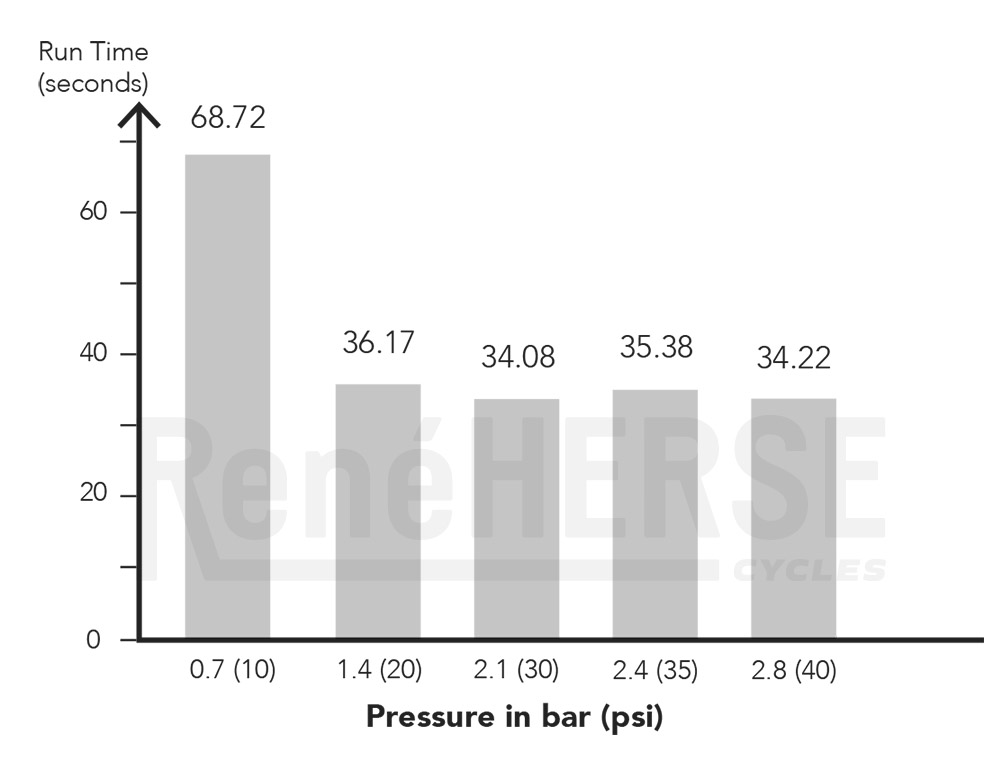
Tire Pressure
The question of optimum tire pressure is both simple and complex. The simple part: With supple tires, pressure doesn’t make a big difference. Above are the rolldown times for Rene Herse 700C x 42 mm Hurricane Ridge Extralight knobbies on smooth pavement. Whether you ride them as high as 40 psi or as low as 30 makes no real difference. At 20 psi, the tires become quite wobbly, so you don’t want to ride them that low – and yet you could without losing much speed. At 10 psi, the tires are almost unrideable – and finally a lot slower, too. In other words, the tires get too soft to ride before they become much slower. That’s the simple part.
The complex part is that there are small differences, and they are statistically significant: The ‘middle’ pressure of 35 psi – what I’d have chosen in the past as a ‘good compromise’ – is actually a little slower than either high (40 psi) or low (30 psi) pressures. We’ve found this with other tires as well, so it’s not just a fluke with these tires or some testing error. The effect is small – if we plug it into the calculations of realistic road speeds, we’re looking at a difference of about 0.15 km/h (0.1 mph) at most. Of course, what ‘middle pressure’ means depends on the tire and the rider’s weight. (For a 25 mm racing tire, the slower ‘middle pressure’ is around 100 psi.)
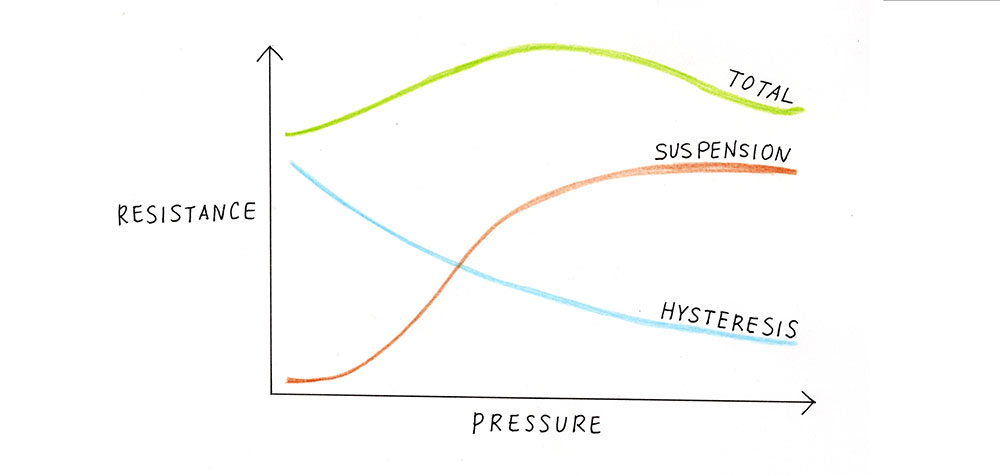
The mechanism behind this appears to be this: As the tires are pumped up harder, suspension losses (caused by vibrations, brown) increase more than the hysteretic losses (caused by deformation of the tire, blue) go down. As a result, the total combined resistance (green line) goes up at first. So you can either minimize suspension losses (low pressure) or hysteretic losses (high pressure), but the ‘compromise’ means that both suspension and hysteretic losses are relatively high, and you go slower than you would at either end of the spectrum.
What does this mean in practice? This testing was done on a very smooth road – on a rougher road surface, higher pressures are always going to be slower. (We tested that, too.) Unless you ride on very smooth roads all the time, low pressures are going to be faster, until you reach the point where the tire becomes wobbly and really slows down. There are two caveats: 1. Always keep your pressure high enough that your tire doesn’t collapse under hard cornering or braking (a clear sign that you are getting into the too-low/slow pressure range). 2. Low pressure puts more stress on the casing: The sidewalls of your tires may wear out before the tread rubber gets thin. (You’ll notice that your tires become more porous and not seal up tubeless any longer.)
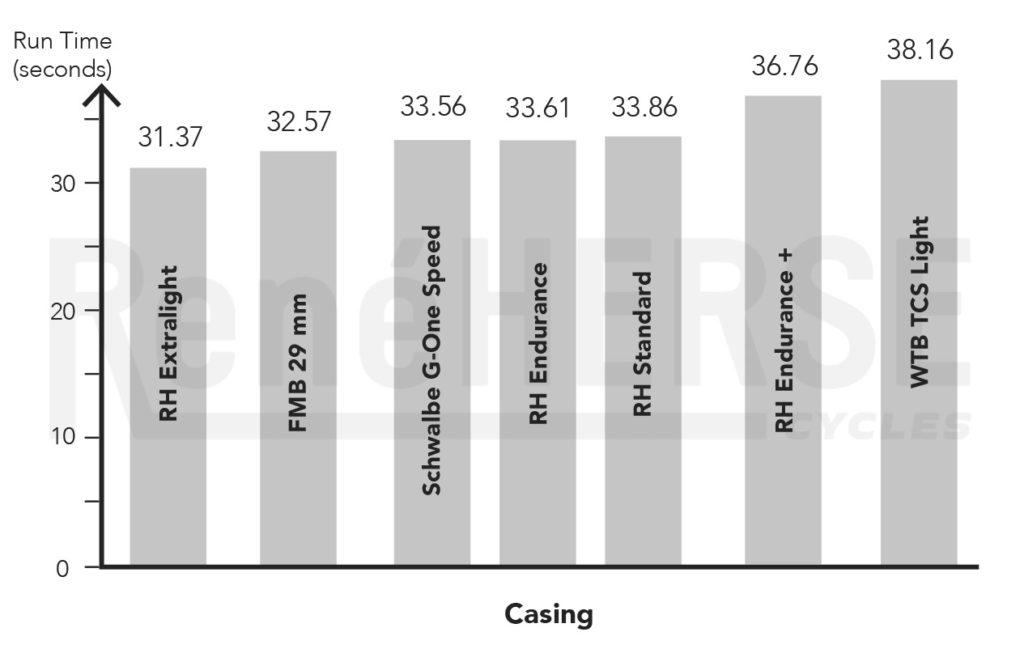
Casings
Our testing confirmed what professional racers have known for decades: A supple casing is the most important component to make a tire comfortable and fast. This is much more important than the small differences we’ve seen above with tire pressure. It’s more important than almost any other change you can make on your bike. (Let’s assume you’re already riding a performance bike with a relatively inclined position and wear close-fitting clothing.)
Above are our four casings (Extralight, Standard, Endurance, Endurance Plus) and three tires from other brands with the fastest casings that these makers offer. All tires have smooth treads and measure between 44 and 48 mm actual width. (Except the FMB cotton clincher, which is not available that wide.) Small gaps between the bars mean that the differences are not statistically significant. Large gaps mean they’re significantly different.
The Rene Herse Extralight rolls fastest, closely followed by the FMB cotton clincher. The Schwalbe G-One, Rene Herse Standard and Rene Herse Endurance all roll at the same speed. The Rene Herse Endurance Plus is a bit slower – the difference to the Standard/Endurance casing is roughly the same as from Standard/Endurance to Extralight. The WTB may seem like a lone backmarker, but its performance is actually quite respectable for a tire that is mostly intended as an OEM tire (and thus has to meet an extremely competitive price point). (We bought ours at a local shop, but they seem to be the same as the OEM version.)
Before we continue, I want to say that I’m not entirely comfortable sharing our data that shows our tires being fastest. We performed these tests to assess the performance of our Rene Herse tires, not for marketing purposes. I’d prefer to see independent testing, but we don’t know of anybody doing real-road testing of tires.
In the end, the goal of our tests is not to persuade skeptics, it’s to develop better tires. And those who’ve ridden all these tires won’t be surprised by the test results – you can feel the differences on the road.
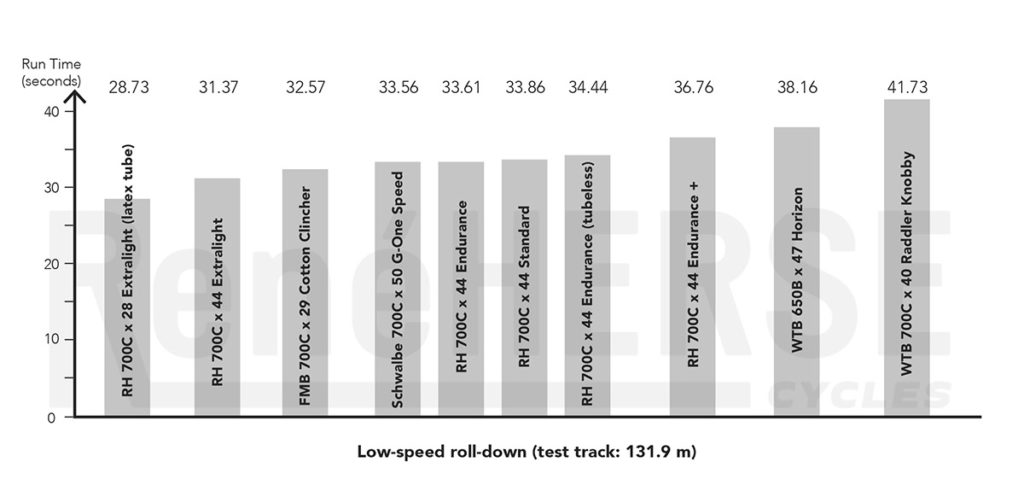
Different Tires
This is the graph everybody wants to see – showing the performance of the actual tires you can buy. We also included latex tubes from FMB, tubeless setup, and a knobby OEM gravel tire. (Unless specified, the tires were run with lightweight butyl tubes.)
Latex tubes make a big difference. At least when combined with a supple casing, they provide an advantage that’s similar to going from the Rene Herse Standard to the Extralight casing. We also ran our Endurance casing tubeless – we actually used the same tires, taking out the tubes and mounting them tubeless between test runs. Tubeless or with a butyl tube makes no difference in speed. Removing the thin rubber membrane of the tube should make the tire faster, but adding liquid sealant increases resistance and slows it down. (If we make the tire airtight without sealant, we need to add a rubber membrane to the casing, which also makes it slower – we tested prototypes of our tires with the rubber membrane, but decided not to put them in production.)
This settles the tubes vs tubeless question: If you want to go fast, use latex tubes. Choose tubeless because it’s less prone to pinch flats, not for speed. Run butyl tubes if you prefer easy setup and don’t want to top up sealant frequently.
The figure above shows the actual sizes of the tires in this test. As we’ve seen earlier, how wide a tire is doesn’t affect its rolling resistance. 28, 32, 35, 38 and 44 mm tires all perform the same if they use the same casing and tread pattern. We’ve tested this for our Rene Herse tires, but it’s probably true for other tires, too.
All the tests above were done at low speeds to tease out differences in rolling resistance. At low speeds, we don’t have to worry about very small variations in rider position that affect the aerodynamics. The low speed is the reason why the test bike is a whopping 45% slower with the slowest tire than with the fastest. Of course, few of us ride at 8 mph (13 km/h)… What we really want to know is what all this means at more realistic speeds.
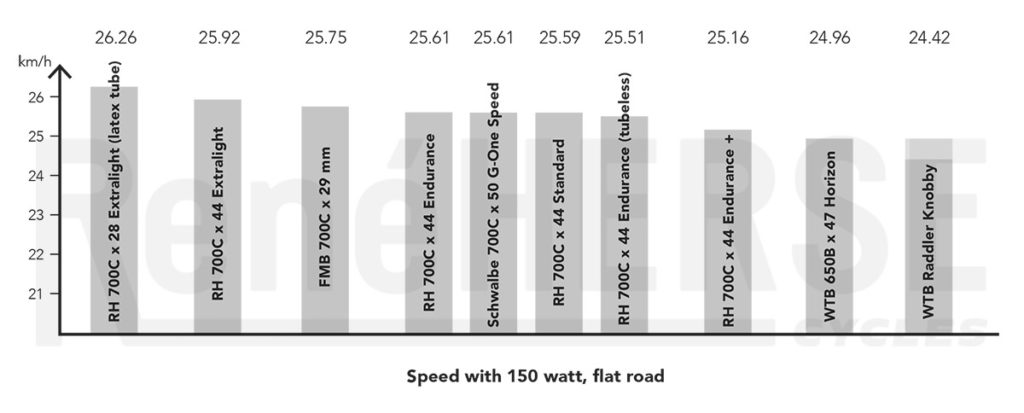
Flat Road, 150 Watt
To put these results in context, we calculated the speeds for each tire with a power output of 150 watts. We used the drag coefficient and frontal area from Bicycle Quarterly’s wind tunnel tests, the tester’s weight, etc., and plugged all those known factors into www.analyticcycling.com. Each rider’s speed will vary a bit depending on these variables, but the difference between the tires will be similar.
Now we can see what this means in the real world… If we switch from the Rene Herse Standard casing to the Extralight, we’ll go 0.3 km/h (0.2 mph) faster with the same effort. Going to the Endurance Plus casing, we give up about the same amount (0.4 km/h; 0.3 mph). The difference between the fastest and the slowest smooth tires is 1.3 km/h (0.8 mph) – or about 5% of the bike’s speed. (The light-colored shaded area for the Raddler knobby indicates that we don’t really know how this tread profile behaves at higher speeds – unlike smooth tires, knobbies have complex dynamics as the knobs flex differently at different speeds.)
This shows that choosing your tires makes a significant difference – a set of aero wheels makes you only about 1-2% faster, but choosing the right tire easily can make a difference of 5% or more. You’ll have to pedal a lot harder if you’re on the slower tires in this test and want to keep up with someone on really fast tires. For this round, we only tested tires that are relatively supple – in our previous tests, we included stiffer tires and found even bigger differences.
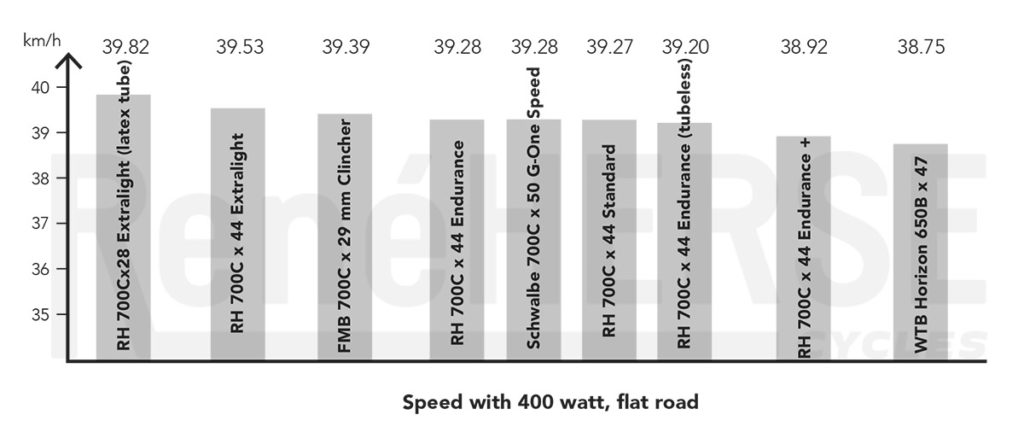
Flat Road, 400 Watt
Let’s assume our rider is a really strong racer and puts out 400 watt – which means they ride at about 25 mph (40 km/h). As a percentage of speed, the differences get smaller at higher speeds – aerodynamics make up a larger portion of the resistance. In absolute terms, the speed differences remain almost constant: Going from the Standard to the Extralight casing still makes our rider roughly 0.3 km/h (0.2 mph) faster, and you give up a similar amount going to the Endurance Plus casing. And the difference from the slowest to the fastest tire is still about 1 km/h (0.6 mph). In a strong group of well-matched riders, these differences are hard to overcome with leg power alone. And remember that when you’re drafting, wind resistance is much smaller, and tires play an even bigger role.
Now you know why pro racers all ride on supple casings – on slow tires, they’d have to be a lot stronger than the others just to keep up!
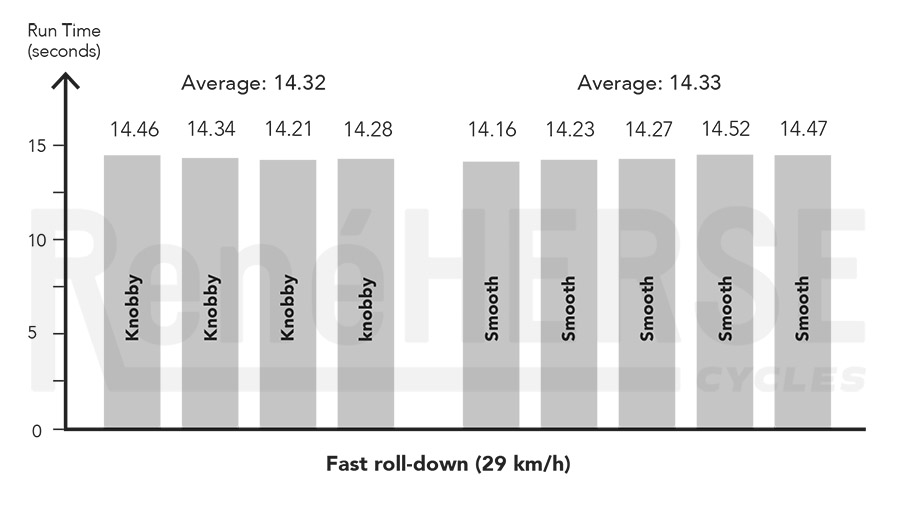
What about Rene Herse Knobbies?
We designed our dual-purpose knobbies to roll (almost) as well as our smooth tires. Many riders report setting personal bests on our knobbies – on pavement. Above is a comparison of our knobby Steilacoom and our smooth Barlow Pass, both in the 700C x 38 size and with Endurance casings, at a speed of roughly 29 km/h (19 mph; individual runs shown). There’s no measurable difference between the knobbies and their smooth-treaded equivalents. The averages are identical, and the variability between the nine runs is just 0.31 seconds. If there’s a difference between these tires at moderate and high speeds, it’s extremely small – too small to matter even for competitive cyclists.
There are a number of reasons for this. The biggest is that the knobs of the Rene Herse tires are so big that they don’t squirm signficantly. There’s a lot more to the performance of knobby tires than we can cover in this journal entry. At low speeds, the knobbies are a little slower, because the knob edges deform – at least when they are new. As the knobs round off with wear, they get faster at lower speeds, too. If you’re interested in the full story, check out the Spring 2021 Bicycle Quarterly.
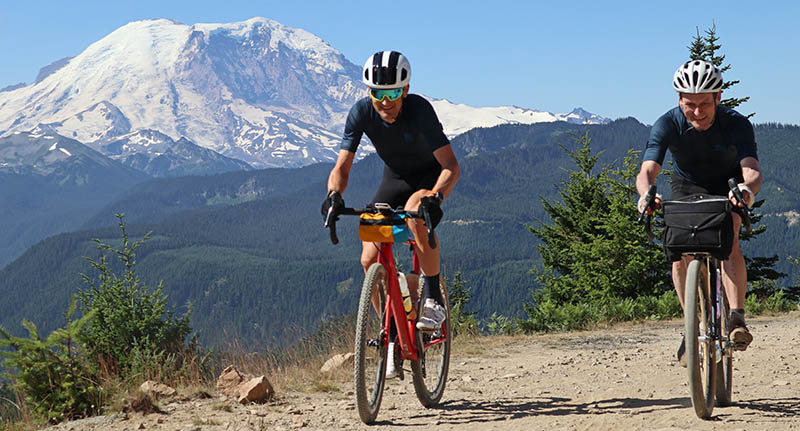
Summary
All this data is interesting, but let’s not forget why we test tires and obsess over supple casings: Great tires make riding so much more fun. They make adventures possible that used to be just the stuff of dreams. Which tires you choose is mostly based on personal preference and riding style. In the photo above, Ted King is running Rene Herse 42 mm knobbies with Endurance casings, while I’m on 54 mm smooth Extralights. Perhaps my tires were a little faster, but Ted more than made up for that with his superior power. On the dry gravel that we encountered on that day in the heart of the Cascade mountains, the tread also made no real difference. It’s good to know that no matter which Rene Herse tires you choose, it’s hard to go wrong.
With wide tires, there are fewer compromises than in the past: supple tires are both fast and comfortable, and thanks to their low pressures, they also don’t get a lot of flats. More flat protection in the casing always comes at the expense of speed, but our goal in developing the Endurance and Endurance Plus casings with Ted has been to minimize these compromises. Our Endurance casings use the same ultra-fine threads as the Extralights, but in a denser, stronger weave and with a cut-resistant layer covering sidewalls and tread. Thanks to the high-end materials, the Endurance casings roll as fast as more economical tires with less protection – like our Standard casing or Schwalbe’s G-One Speed. Our Endurance Plus is one of the toughest tires you’ll find this side of tires for downhill mountain biking, yet it’s still surprisingly fast thanks to the high-end materials used for its construction. Our testing shows it’s faster than the OEM tires found on many production gravel bikes.
That also points to the downside of supple tires: cost. The best materials are expensive. The raw casings are fragile until they are vulcanized (baked) into a tire, so they must be handled carefully, by skilled workers. All that has a price, but we feel its worth the effort: A great, supple tire transforms the feel and performance of your bike more than any other component. That’s why we leave no stone unturned to optimize our tires for real-road riding.
Further Reading:
• Ted King’s Water Cooler Talk about tires with Lael Wilcox and Jan as guests.
• How to pick your Rene Herse tires? We help you choose the right tread pattern, width, casing, etc.
• Which Casing is Right for Me? More information about each casing.
• Our book ‘The All-Road Bike Revolution’ discusses the research that has revolutionized our understanding of how bikes work: tire performance, frame stiffness, frame geometry and every other aspect that determines the performance, comfort and reliability of your bike.
Thank you to Enve for the loan of several Enve 45 wheelsets that were used for these tests.


